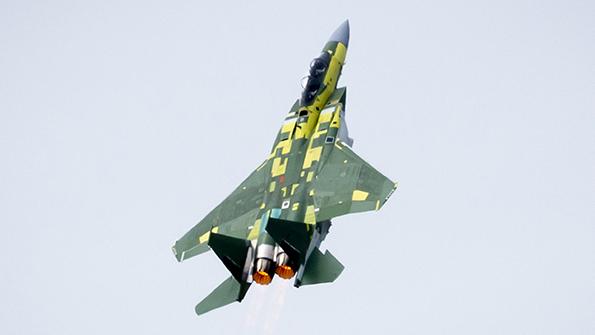
More than 1,000 military engines could be in competition after two recent moves by U.S. Air Force acquisition officials.
Facing legal pressure from Pratt & Whitney, the Air Force agreed to perform a market survey for engine options to power the Boeing F-15EX after the first production lot, which potentially opens the door to a competition between Pratt’s F100-PW-229 and the GE Aviation F110-GE-129.
The Air Force also initiated the second phase of a source selection process for the B-52 Commercial Engine Replacement Program (CERP), which seeks to acquire 608 modern turbofans and spares to replace the aging Pratt TF33 on each of the eight-engine bombers over the next 15 years.
- F-15EX program starts market research on F100
- Source selection phase starts for B-52 reengining
In a U.S. military aviation market with few orders up for grabs, engine manufacturers GE, Pratt and Rolls-Royce are entering what could be an industry-defining period of competition. Pratt has a clear lead over its rival with sole-source positions as the propulsion supplier for the Air Force’s Lockheed Martin F-35A fighter, Northrop Grumman B-21 bomber and Boeing KC-46 tanker. But Pratt’s competitors have scored major wins in the last two years with the GE F404 selected to power the Boeing T-7A trainer and Rolls’ AE3007 set to be installed on the Navy’s Boeing MQ-25As.
Seeking to introduce the F-15EX as quickly as possible and replace aging F-15Cs, the Air Force initially decided to forgo a competition for the engine. Although Pratt’s F100-PW-220 and -229 are the only powerplants on the Air Force’s F-15E fleet today, GE’s F110 is the only engine qualified on a configuration that includes two major updates for the F-15EX, which comprise a fly-by-wire control system and a redesigned wing.
Pratt still struggled to decide how to react after the Air Force published a notice of intent in late January to award the sole-source engine contract to GE. “There were some long days in February and late January when we were trying to decide if this is something that we want to protest,” says Mark Beierle, Pratt’s F100 program director. “But you just want to be a part of the competition. We think we have a legacy with the program. We have a very viable engine.”
In response to the sole-source decision, Pratt submitted a capabilities statement to the Air Force about the F100 and filed a protest with the Government Accountability Office in hopes of forcing a competition. Ultimately, the Air Force decided to meet Pratt halfway. The GAO dismissed the company’s complaint in March, and the Air Force has launched a market research study. The first lot of engines for eight F-15EX fighters procured in Lot 1 will be awarded to GE, but the study will consider the readiness of the F100 to compete for future production lots.
“We believe that a fair opportunity to compete is the best thing for the warfighter,” says Kinda Eastwood, Pratt’s executive director for integrated customer solutions.
By contrast, a healthy competition is underway for the B-52 CERP contract. Four engines—GE’s CF34-10 and Passport powerplants, Pratt’s PW800 and the Rolls-Royce BR.725, which is marketed to the Air Force as the F130—are competing for the order. All three companies submitted virtual prototypes of the engines and completed an integration risk analysis with Boeing in Phase 1 of the competition. The Air Force now has initiated the Phase 2 source selection process, with final bids due in July.
The Air Force prizes bids that can deliver more fuel efficiency than the minimum requirement, with pricing credits worth up to $375 million available for more fuel-efficient engines. Pricing credits worth up to $125 million also are available for engines that exceed the Air Force’s threshold requirement for unscheduled engine removals.
The challenge will be to adapt a modern engine to the mounts, pylon structure and avionics of the B-52. By selecting an eight- rather than a four-engine replacement configuration, the Air Force minimized changes to the wing structure and the need to adapt the rudder to overcome greater adverse yaw caused by an outboard engine failure. But the introduction of modern engines with full-authority digital engine controls has driven a requirement to update the avionics displays in the cockpit.






Comments
Perhaps Pratt & Whitney should pay for a complete F-15EX, and the process to certify the F100 in this new variant, in order to provide a second engine option for the F-15EX.